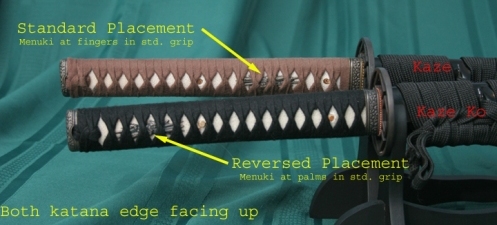Menuki placement. Menuki are the ornaments afiixed to the handle, between the rayskin and the wrapping. They were originally decorations used to cover the sword retaining pins (mekugi); however, in later times they became practical in that when placed where the palm meets the handle, the resultant gap was filled. This "palm swell" created a more comfortable grip, quite similar to today's custom pistol grips which are designed to "fill" the palm.
The tachi was sworn slung from a belt with the cutting edge down. Therefore the right hand menuki, when viewed from the obverse (omote) side, was placed closer to the retaining pin (Fig.7); the left hand menuki, on the reverse (ura) side, was placed closer to the pommel.
When the tachi-styled sword transitioned in the late 16th century to the uchigatana (worn edge-up, thrust though a sash), the convention remained of placing the omote menuki close to the retaining pin (Fig. 8). This practice resulted in the menuki being on the opposite side of the palm--practicality had been superceeded by strict adherence to format.
Few schools of swordsmanship retained the practical method of positioning the menuki. The one notable traditional style is Yagyu Ryu; the modern styles which adopted this method are Toyama Ryu and Nakamura Ryu.
Wrapping the menuki to the handle came about during the Muromachi period (1338-1573) when the fittings were generally in the handachi (half-tachi) style. The Imperial Army and Navy military swords of 1933-1945 were also outfitted in the handachi style, and the menuki were placed where the palms of the hand meet the handle.
Essentially, the menuki become useless ornaments for the handle when positioned in the Edo style. However, if the menuki are affixed in the handachi style, one's swordsmanship will become satisfactory. Ninety per cent of the swords used by today's iaido enthusiasts have the Edo style menuki placement.
source





 .
.





Bookmarks